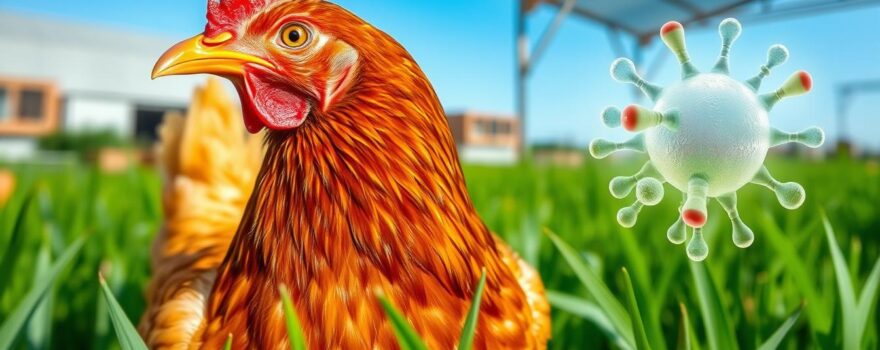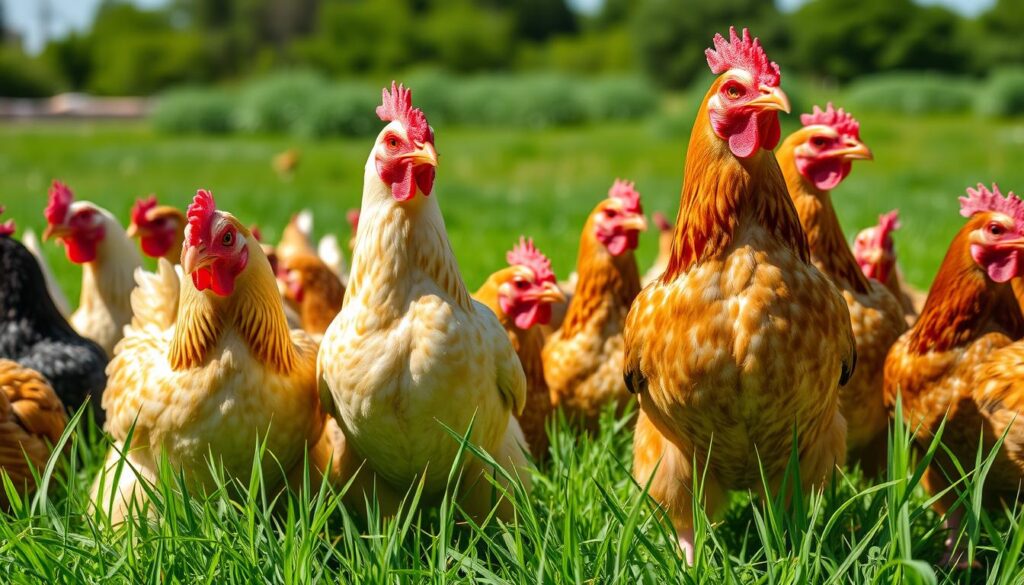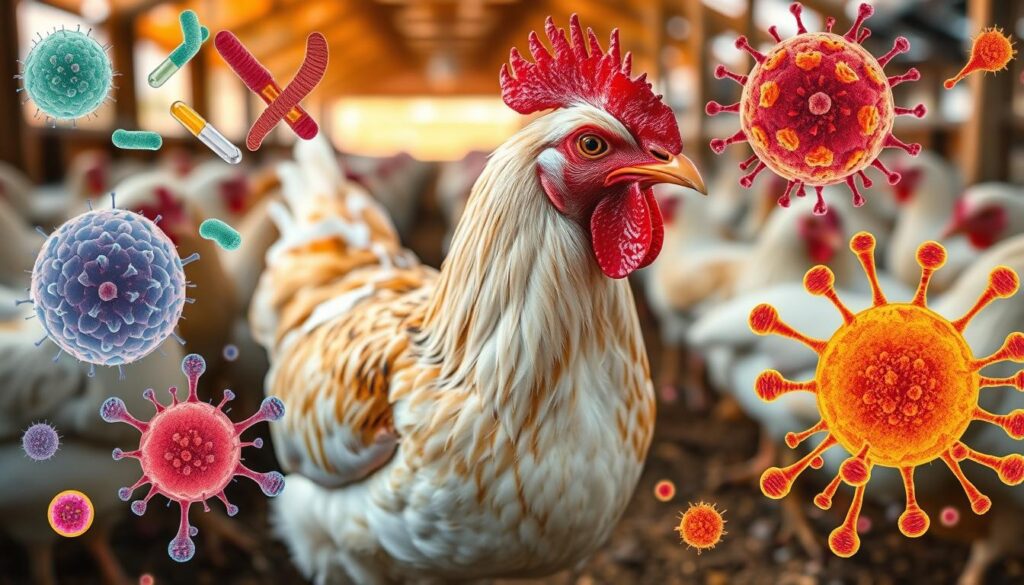
Antibiotic resistance is a big problem worldwide. It’s a major threat to broiler chicken health. Antibiotics used in farming, for health and growth, have made bacteria resistant. This leads to failed treatments, more deaths, and big economic losses.
It’s key to know how antibiotic resistance affects broiler chickens. The rise of resistant bacteria in farms makes treating infections hard. This risks the health and work of broiler chickens. It also affects the whole poultry industry, making it urgent to tackle antibiotic resistance.
Key Takeaways
- Antibiotic resistance is a global concern with significant implications for broiler chicken health and the poultry industry.
- The widespread use of antibiotics in poultry farming has contributed to the development and spread of antibiotic-resistant bacteria.
- Antibiotic-resistant pathogens can compromise the ability to effectively treat bacterial infections in broiler chickens, leading to treatment failures, increased mortality, and economic losses.
- Understanding the impact of antibiotic resistance on broiler chicken health is crucial for developing effective strategies to address this pressing issue.
- Addressing the problem of antibiotic resistance in broiler chicken production is an urgent priority for the poultry industry.
The Global Rise in Poultry Production
The demand for poultry products, especially broiler chicken, keeps growing. This is because the world’s population is increasing. People want affordable and easy-to-get protein sources. Poultry meat, making up about one-third of all meat, is key in the global food system.
World Population Growth and Increasing Meat Demand
The poultry industry is expected to grow, meeting half of the world’s meat needs in the next decade. In 2020, poultry meat production hit 137 million tonnes, up 2.6% from 2019. The USA, Brazil, the European Union, and China lead in poultry meat production.
Broiler Chicken Production Statistics and Trends
Broiler chicken production has seen a big jump in recent years. In 2014, poultry meat production was 108.5 million tons worldwide. By 2023, it’s expected to reach 134.5 million tons. This growth is driven by population increase and the desire for chicken as a lean, affordable protein.
This growth is especially seen in South Asia, where poultry meat demand is set to jump by 725% by 2030. But, this fast rise in global poultry production trends has raised worries about antibiotics in poultry farming and antibiotic resistance.
“Antimicrobial drug use in livestock is expected to increase by 67% by 2030, reaching approximately 105,500 tonnes.”
Antibiotics in Poultry Farming
Antibiotics are key in modern poultry farming. They help treat and prevent diseases in chickens. They also boost growth and efficiency. But, their widespread use without control has led to more antibiotic-resistant bacteria.
Reasons for Antibiotic Use in Poultry Production
Antibiotics are used for several reasons in poultry farming:
- Disease Prevention: They stop bacterial infections from spreading in chicken flocks.
- Treatment of Infections: Sick chickens get antibiotics to fight off infections and get better.
- Growth Promotion: Antibiotics help chickens grow faster and use less food.
The misuse of antibiotics has made bacteria resistant. This is a big risk for animals and people.
| Statistic | Details |
|---|---|
| Antibiotic-resistant E. coli rates | Higher than 40% in all countries, except for ampicillin in the US. |
| Resistance rates to fluoroquinolones and quinolones | Below 5% in the US, where these antibiotics are not registered for use, while above 40% in Brazil, China, and the EU, where they are legal. |
| Reduction in tetracyclines’ use in France | Led to a decrease in detected resistance rates. |
| French poultry industry antibiotic consumption | 106 metric tons of active antibiotic substances in 2016, representing 20% of all veterinary antibiotics and an average annual consumption of 47 mg per kilogram of chicken produced. |
| Most commonly used antibiotics in French poultry herds in 2016 | Polymyxins, penicillins, tetracyclines, sulfonamides, and trimethoprim. |
The overuse of antibiotics in poultry farming is a big problem. It’s linked to antibiotic resistance. This is a serious threat to health and needs urgent action.
The Emergence of Antibiotic Resistance
The overuse of antibiotics in poultry farming has led to emergence of antibiotic-resistant bacteria. Bacteria exposed to many antibiotics develop resistance. This makes treating diseases harder and increases outbreak risks.
Recent data shows 80% of U.S. antimicrobial agents are used in animal farming. Globally, over 70% of antimicrobials are used in food animals. By 2030, antimicrobial use is expected to rise by 67%, mainly in low- to middle-income countries.
The emergence of antibiotic resistance in broiler chickens is complex. Many factors contribute to its development. Knowing these factors is key to solving this problem.
| Statistic | Value |
|---|---|
| Chickens (Gallus gallus domesticus) comprise 90% of global poultry production | Approximately 23 billion chickens |
| Global poultry annual growth rate | 5%, compared to 1.5% for beef, 3.1% for pork, and 1.7% for small ruminants |
| Antimicrobials sold and used in the U.S. poultry industry in 2016 | 3,345,022 kg, with 1,265,420 kg being “medically important” in human medical therapy |
| Broiler operations using antibiotics for production purposes not related to disease control | 20–52% |
The factors contributing to antibiotic resistance in poultry include using antimicrobials for growth and disease prevention. The rapid growth and intensification of the poultry industry also play a role. These practices help antibiotic-resistant bacteria grow.
“It is estimated that over 60% of all antibiotics produced are used in livestock production, including poultry.”
The emergence of antibiotic resistance is a big threat to the poultry industry. It makes treatments less effective and raises disease outbreak risks. Understanding these factors is crucial for finding solutions and ensuring the poultry industry’s future.
Impact of Antibiotic Resistance on Broiler Health
Antibiotic resistance is a big problem for broiler chickens. Bacteria like Escherichia coli, Salmonella, and Pseudomonas aeruginosa can cause serious infections. These infections can lead to breathing and digestive problems, and even death.
This affects the health and success of the poultry industry. It makes it hard to keep broiler flocks healthy and productive.
Bacterial Pathogens Affecting Broiler Chickens
Antibiotic-resistant bacteria are hard to treat in broiler chickens. In 2021, Portugal produced 313 thousand tons of chicken meat. But, the use of antibiotics like tetracyclines and penicillins is still high.
This raises concerns about antibiotic resistance in broiler health.
Respiratory and Gut Health Issues
Antibiotic resistance can mess with chickens’ digestion and breathing. The use of antibiotics in broiler farming has gone up a lot. Over 80% of poultry meat in Europe is chicken, and the industry is growing fast.

Dealing with antibiotic resistance in broiler chickens is a big challenge. We need to watch closely, use antibiotics wisely, and find new ways to keep chickens healthy. This is key to protecting the broiler industry’s health and success.
Transmission of Resistant Bacteria to Humans
Antibiotic-resistant bacteria in poultry production harm both chickens and humans. These bacteria can spread through the food chain and environmental contamination. Poultry products like meat and eggs can carry these resistant pathogens. Also, antibiotics used on farms can leak into the environment, spreading resistance genes.
Food Chain and Environmental Contamination
Resistant bacteria can move from poultry to humans in many ways. Meat and eggs can get contaminated during processing. This leads to food chain contamination with antibiotic-resistant bacteria. Farms can also spread these bacteria through soil, water, and air, increasing human exposure.
| Antibiotic Resistance Prevalence | Avian E. coli Isolates | Human E. coli Isolates |
|---|---|---|
| Tetracycline | 82.4% | 43.8% |
| Kanamycin | Higher (p | Lower (p |
| Nalidixic Acid | Higher (p | Lower (p |
| Chloramphenicol | Lower (p | Higher (p |
| Gentamicin | Lower (p | Higher (p |
The table shows antibiotic resistance differences between avian and human E. coli. It highlights the risk of transmission of resistant bacteria from poultry to humans. It also stresses the need for food chain and environmental monitoring to tackle this public health issue.
“The release of antibiotic-resistant bacteria and residues from poultry farms into the surrounding environment can contribute to the spread of resistance genes, affecting both human and animal populations.”
Surveillance and Monitoring of Resistance
It’s key to watch and track antibiotic resistance in poultry closely. This helps us understand the problem better and find ways to fight it. We use phenotypic and genotypic testing methods to check how bacteria in broiler chickens react to antibiotics.
Phenotypic testing, like the Kirby-Bauer disk diffusion method, shows how well bacteria fight off antibiotics. It helps us find out which bacteria are resistant. This is important for choosing the right treatments and for using antibiotics wisely.
Genotypic Testing Methods
Genotypic testing looks at the genes that make bacteria resistant to antibiotics. It helps us understand how resistance spreads and evolves. This info is key for making targeted efforts to stop resistance.
By using both phenotypic and genotypic testing methods, we get a full view of antibiotic resistance in poultry. This info is crucial for tracking resistance, testing how well our strategies work, and finding new ways to fight infections.
| Testing Method | Description | Key Insights |
|---|---|---|
| Phenotypic | Kirby-Bauer disk diffusion method | Provides information on the susceptibility of pathogens to various antibiotics |
| Genotypic | Identification of genetic determinants responsible for antibiotic resistance | Allows for a deeper understanding of resistance mechanisms and the evolution of resistance genes |
“Integrating phenotypic and genotypic testing methods can provide a comprehensive picture of the antibiotic resistance landscape in the poultry industry.”
The Impact of Antibiotic Resistance on Broiler Chicken Health
Antibiotic resistance is a big problem for broiler chickens. It leads to more diseases, higher death rates, and fewer treatment options. This causes big losses for farmers who try to keep their flocks healthy and productive.
Without effective antibiotics, treating infections is harder. In 2017, 40% of chicken feed was for birds raised without antibiotics. But, removing antibiotics in Denmark led to more use of other antibiotics. This shows the need for careful use of antibiotics.
It’s key to find ways to keep chickens healthy without antibiotics. New methods like organic acids, essential oils, and probiotics are being explored. A mix of smart antibiotic use, better biosecurity, and new disease management is needed to protect chickens.
“Prior to the 1940s, the number of chickens sold for meat in the United States rose from 154 million in 1909 to 588 million in 1949 to more than 1 billion in 1954. Today, more than 9 billion broilers are raised in the United States each year.”
Dealing with antibiotic resistance in chickens is urgent. We need to tackle the consequences of antibiotic resistance in poultry production and find ways to overcome economic and production challenges due to antibiotic resistance. This will help ensure the health of broiler chickens for the future.
Avian Pathogenic E. coli and Resistance
Avian pathogenic Escherichia coli (APEC) is a big problem in the poultry world. It causes colibacillosis, a serious disease in broiler chickens. APEC is resistant to many antibiotics, like ampicillin, tetracycline, and quinolones.
Prevalence and Resistance Mechanisms
The spread of antibiotic-resistant APEC varies by region. But the trend is alarming. In one study, 65% of E. coli from broiler chickens in Qatar were APEC. And 96% of these showed resistance to at least one of 18 antibiotics tested.
Antibiotics like ampicillin, cephalothin, ciprofloxacin, tetracycline, and fosfomycin saw high resistance rates. The resistance in APEC comes from genes like blaTEM, tetA, and qnr. Genetic mutations also play a role.
A study in Nepal found 90.1% of APEC isolates had antibiotic resistance genes. The mcr1 gene was found in 52.6% of isolates.

“All APEC isolates were resistant to at least one antimicrobial agent, with the highest resistance observed against ampicillin (99.4%).”
The high rate of antibiotic-resistant APEC is a big threat to poultry and public health. We need a strong plan to fight antibiotic resistance in poultry. This includes better use of antibiotics and finding new ways to fight disease.
Salmonella in Poultry Production
Salmonella is a harmful bacteria that affects broiler chicken health and production. The rise of antibiotic-resistant Salmonella strains makes it harder to fight diseases like pullorum disease and fowl typhoid in poultry farms.
Pullorum Disease and Fowl Typhoid
Pullorum disease and fowl typhoid are caused by Salmonella. They can cause severe infections in broiler chickens, leading to high death rates. Research shows that Salmonella in chickens often doesn’t respond to antibiotics like ampicillin and tetracycline.
The spread of resistant Salmonella through food and the environment is a big risk for animals and humans. In Colombia, 75% of Salmonella from broiler farms showed antibiotic resistance. In the U.S., different types of antibiotic resistance were found in poultry farms.
| Location | Salmonella Contamination in Poultry | Antibiotic Resistance Prevalence |
|---|---|---|
| Colombia | 33% in chicken meat, 53% in broiler carcasses | 75% of isolates from broiler farms |
| United States | 9% of total chicken production in Delmarva region | 4 different resistance phenotypes observed |
| Singapore | 90% in retail fresh chicken meat | N/A |
The ongoing problem of antibiotic-resistant Salmonella in poultry calls for urgent action. We need better biosecurity, careful use of antibiotics, and new ways to control diseases.
Other Bacterial Pathogens and Resistance
Escherichia coli and Salmonella are well-known in the poultry industry. But, other bacteria like Pasteurella multocida, Avibacterium paragallinarum, Gallibacterium anatis, and Pseudomonas aeruginosa also cause problems. These bacteria have become resistant to antibiotics, making treatment hard.
This resistance leads to more sick birds and lower health and productivity. The European Union’s One Health 2020 Zoonoses Report highlights the issue of antibiotic resistance in poultry. A study found that poultry farmers need better knowledge and practices to handle antibiotics.
Using bacteriocins, antimicrobial peptides, and bacteriophages could be a good alternative to antibiotics. Research also shows that better food safety practices before slaughter can help reduce resistance in broiler chickens.
Monitoring and Surveillance Efforts
The UK’s Veterinary Medicines Directorate released a report on antibiotic use and resistance from 2013 to 2017. It stresses the need to monitor and control antibiotic use in poultry. A study on Campylobacter highlights the need to understand and tackle this pathogen in poultry to fight antibiotic resistance.
It’s important to keep researching and watching the situation. This will help find ways to deal with antibiotic resistance in broiler chickens and other pathogens.
Antibiotic Stewardship and Alternatives
Dealing with antibiotic resistance in poultry needs a mix of antibiotic stewardship and new methods. Cutting down on antibiotics in broiler production is key. This includes better biosecurity, disease prevention, and careful use of antibiotics.
Looking into probiotics, phytogenics (plant-based compounds), and vaccination strategies offers good alternatives. These can help keep broiler chickens healthy and productive. Using these methods can fight antibiotic resistance and keep the broiler chicken industry going strong.
Reducing Antibiotic Use in Broiler Production
In the U.S., 80 percent of antimicrobial agents go to animal production. But, the industry has cut down on antibiotic use a lot. Between 2016 and 2017, sales of important antimicrobials for animals fell by 33 percent. Also, fewer broiler chicks got antibiotics at hatcheries, from 93 percent in 2013 to 17 percent in 2017.
Probiotics, Phytogenics, and Vaccination Strategies
As antibiotics are used less, new ways to keep broilers healthy are being looked into. Probiotics, phytogenics (like coconut oil and thyme), and vaccination strategies are promising. They help with growth and defense against bad microbes, making antibiotics less necessary.
“Developing new antimicrobial drugs is extremely labor intensive, time consuming, and costly, with only a small number of new antibiotics approved since the 1960s.”
By focusing on antibiotic stewardship and new solutions, the poultry industry can face antibiotic resistance head-on. This ensures the future of broiler production.
Antibiotic resistance is a big problem for broiler chickens. It affects the poultry industry and beyond. The use of antibiotics has made bacteria resistant, making treatments less effective. This increases the risk of diseases spreading.
To tackle this, we need a wide-ranging plan. This includes watching for resistance, using antibiotics wisely, and finding new ways to fight diseases. By doing this, the poultry industry can stay strong and healthy for the future.
The conclusion shows we must tackle the summary of antibiotic resistance impact on broiler chickens. We need a plan that includes watching for resistance, using antibiotics carefully, and finding new ways to fight diseases. This will keep broiler chickens healthy and protect human health too.